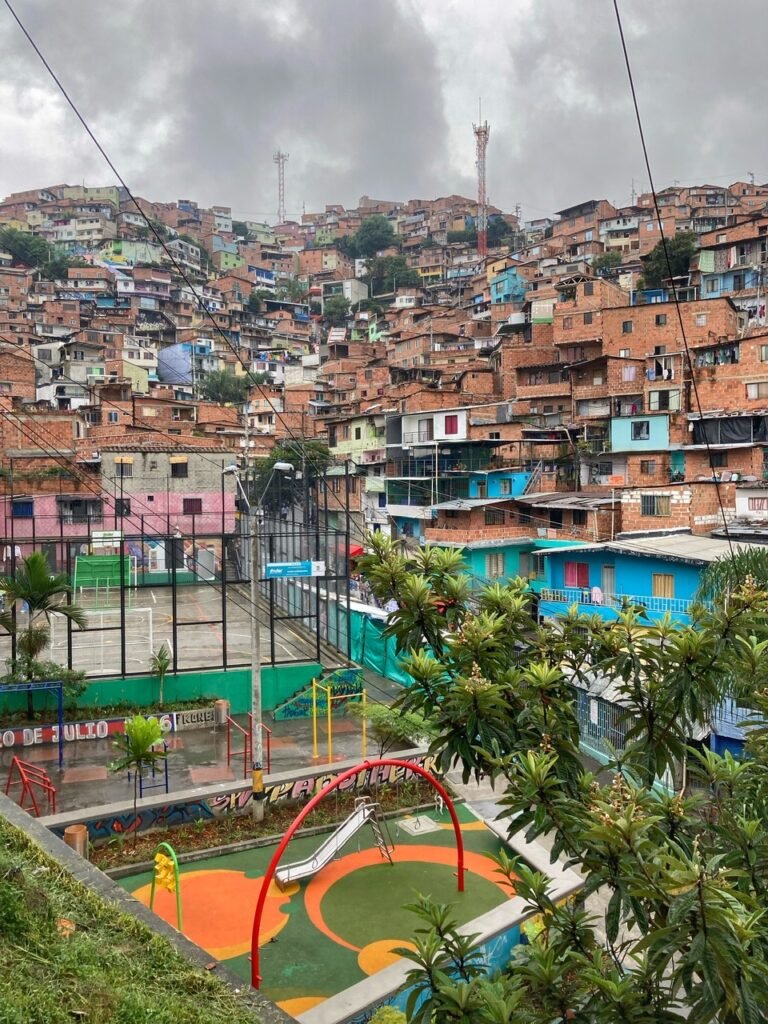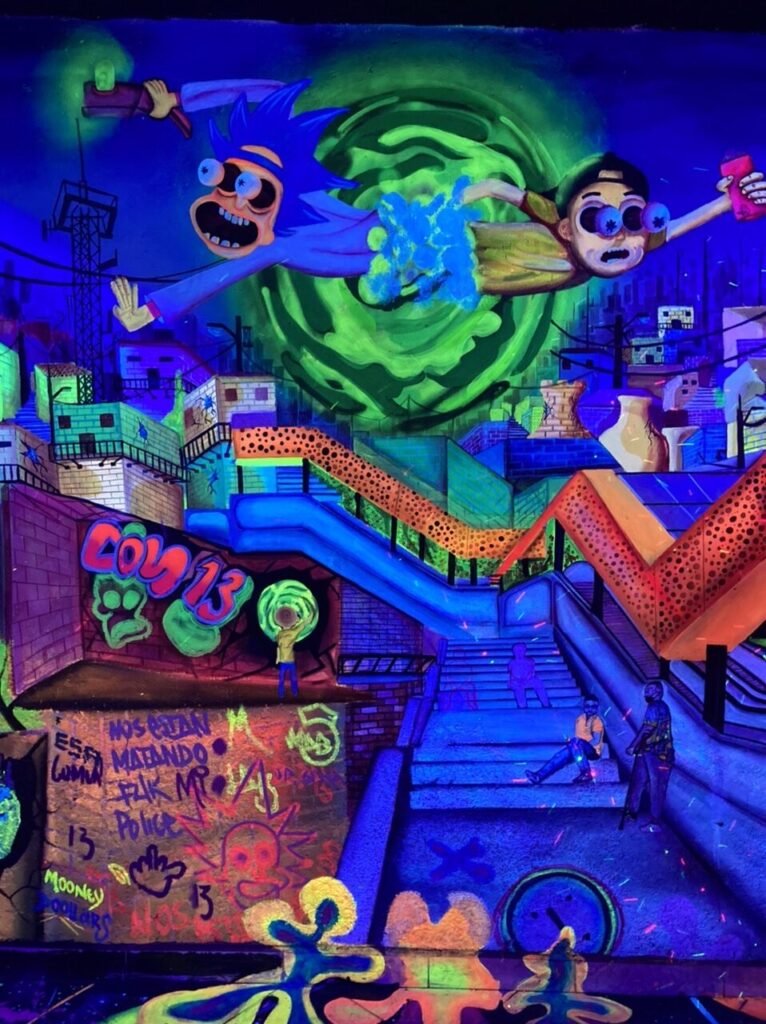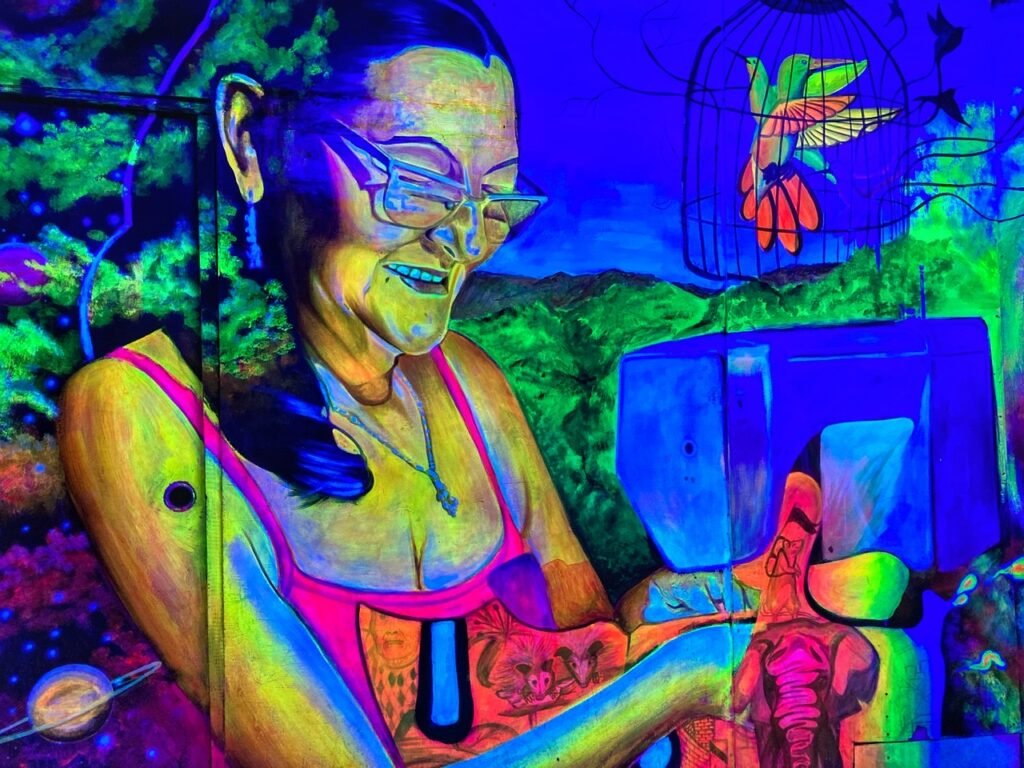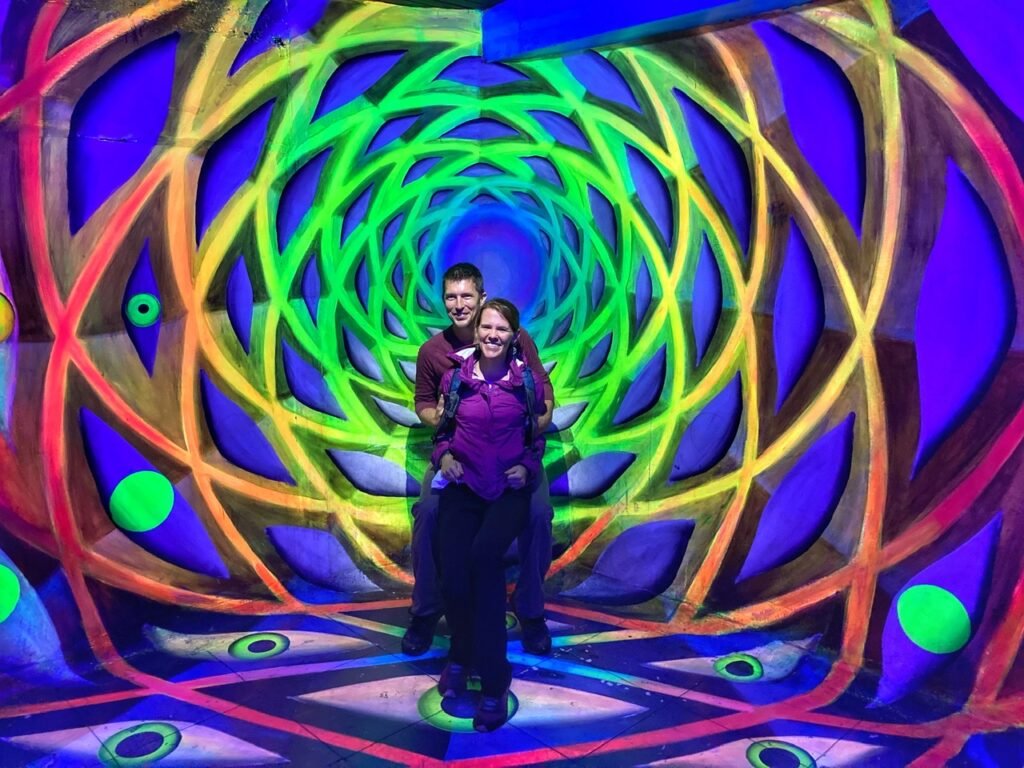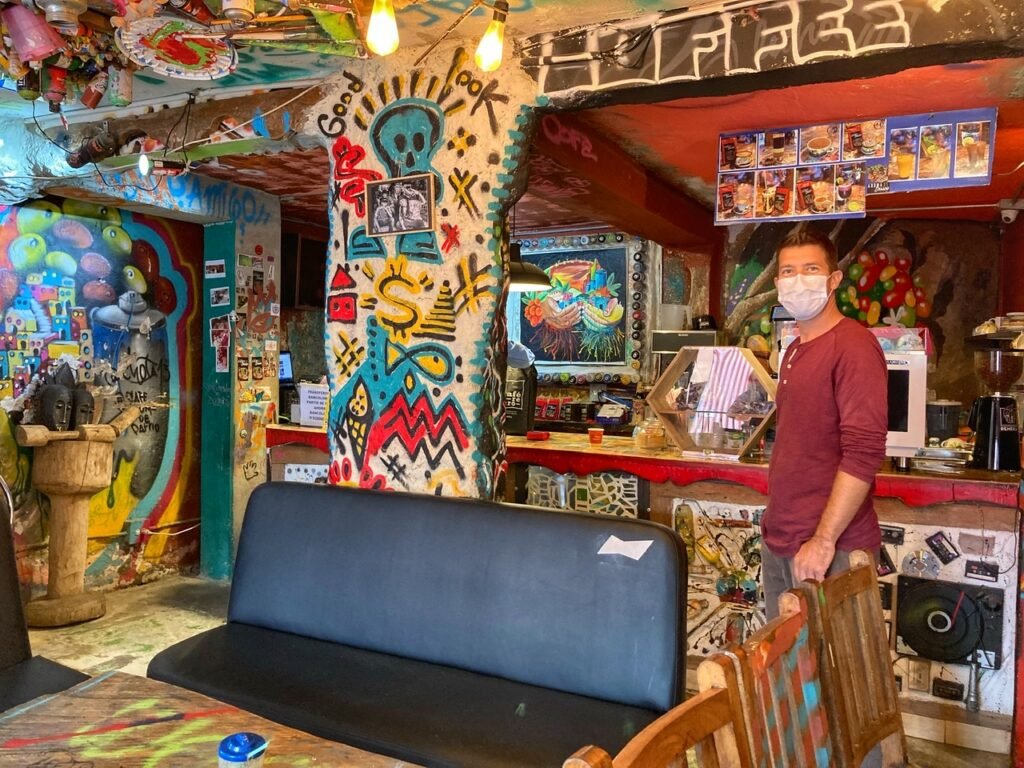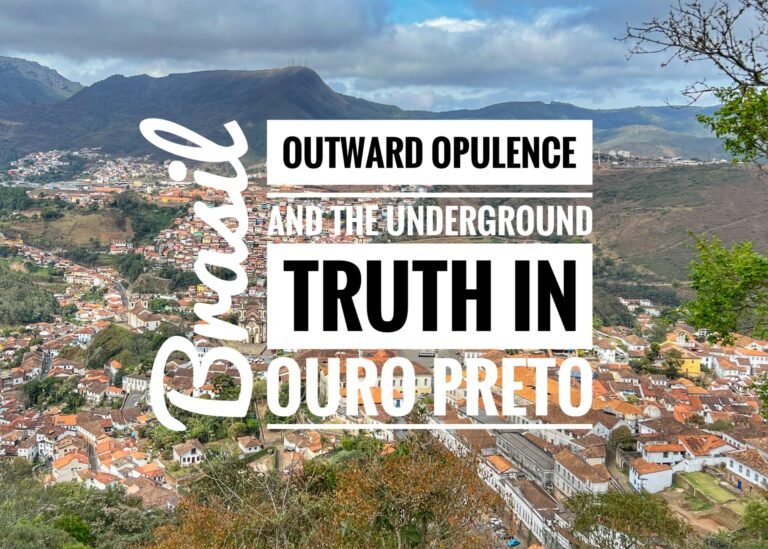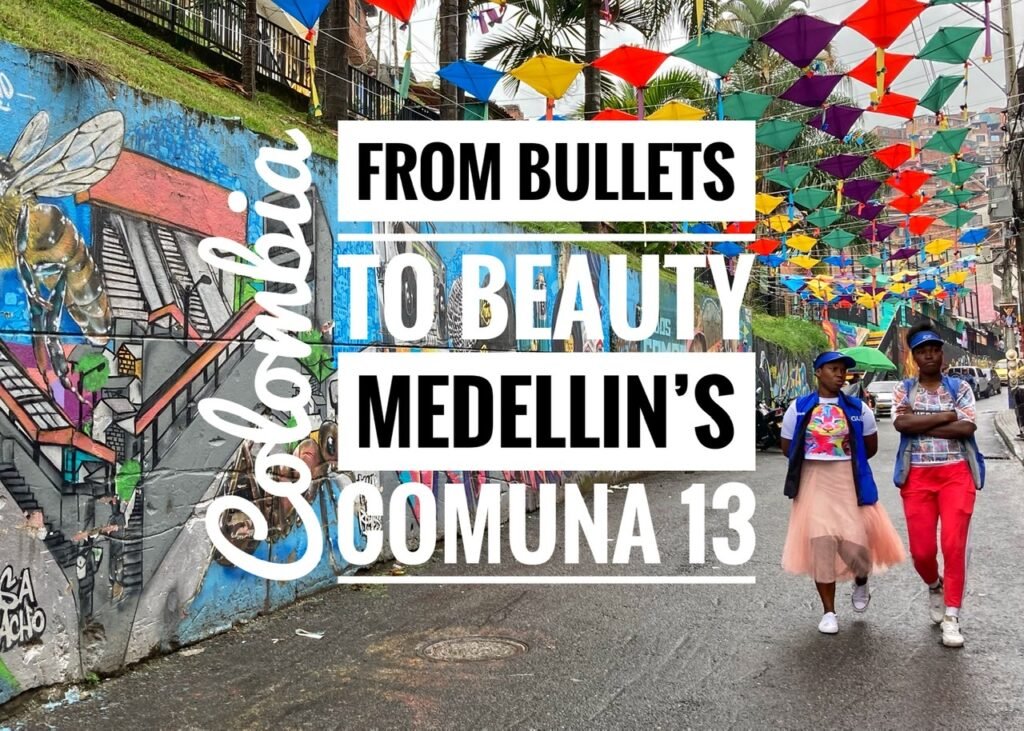
We have a lot of hope. For cities that may be falling into a downtrodden path, for countries ripped apart by wars and dictatorships, and for our planet as it continues an uphill battle against climate change. It’s hard not to have hope when you see a neighborhood like Comuna 13. Less than 25 years ago, this sprawling hillside barrio was considered one of the most dangerous places in the world run by violent drug trafficking organizations, who used this area as a transit route in and out of the city and which served as a stronghold of guerrillas, gangs, paramilitary groups and the Colombian government. Today, through grassroots efforts of the community, it has exploded in quite a different way. It has completely transformed to include an interconnected network of escalators, a passionate street music scene, and undoubtedly the most vibrant and provocative street art we’ve ever laid eyes on. Plus, the people just seem to have a certain glint of hope in their eye as they welcome you left and right. Despite its tumultuous and heart-breaking past, you realize this is one resilient neighborhood.
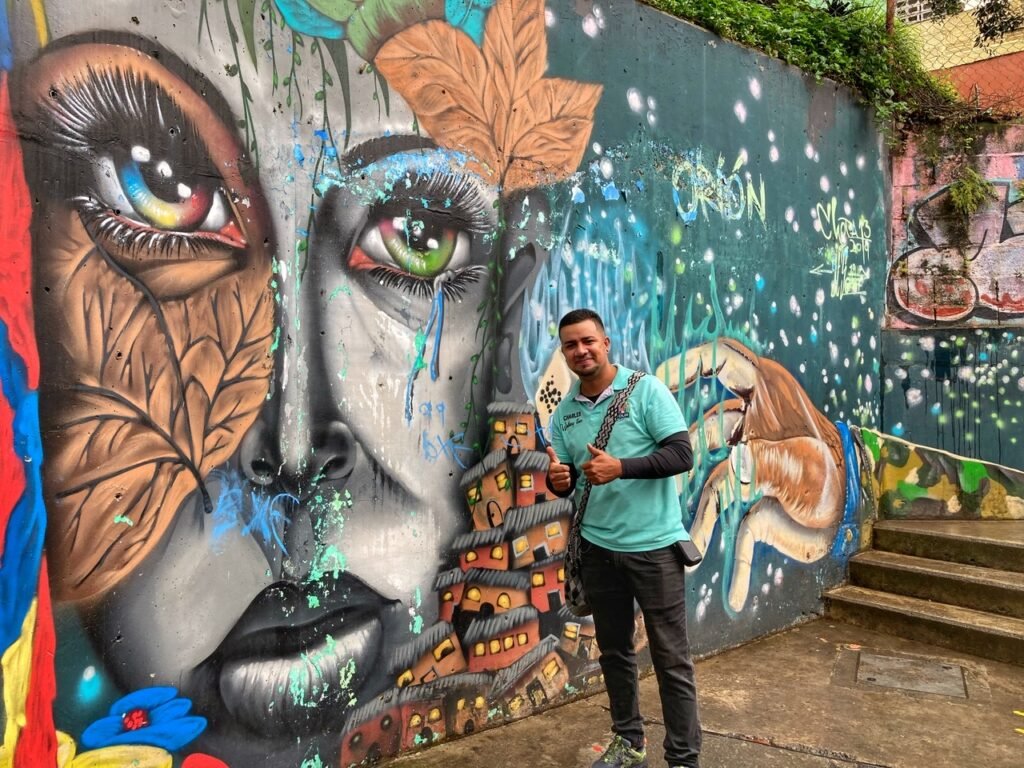
Things started to changed in 2002 when President Alvaro Uribe launched Operation Orion, which was a raid on Comuna 13 spearheaded by 3,000 troops back by helicopters. It was a savage and controversial new beginning because during the raid, and many others, the neighborhood’s 100,000 residents were caught in the crossfire resulting in many deaths and hundreds of injuries. (Atlas Obscura)
We felt very emotional to get to hear one of these stories firsthand from our local guide, Carlos, who was shot in his neck at the mere age of 8. Afterwards, completely displaced, his family immigrated to Spain for their own new beginning. He lived there until four years ago when he moved back to his metamorphosed neighbhorhood to face his past and become a guide, which we booked through Guruwalk. Carlos is pictured here in front of a very important mural by Chota which captures that raid in 2002. At right, you can see a hand reaching out to throw some dice on top of the neighborhood, which succumbs to their strength. On the outside of the sleeve is camouflage representing the government/military and underneath the glimpse of a blue sleeve, representing a different cause. It’s a very tangled and devastating situation.

In this mural, it shows the skull and muscular structure of a little black girl. The message is that we are all the same underneath and she is holding a key up to three birds representing the colors of the Colombian flag.
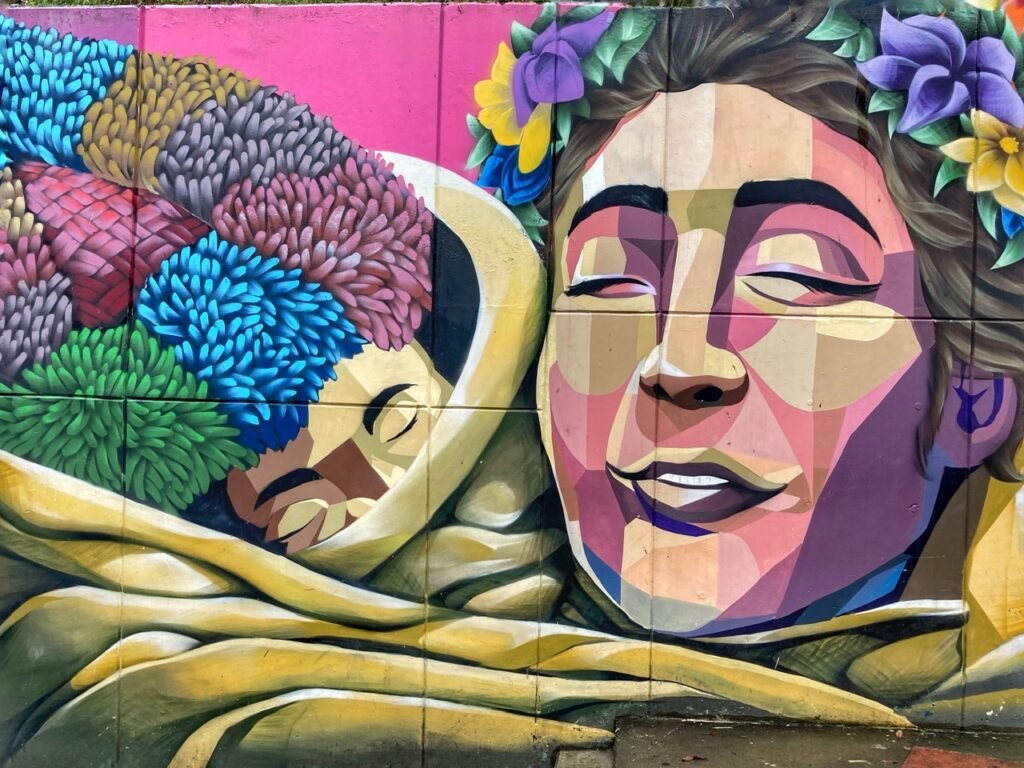
A mother protecting her son in her embrace.
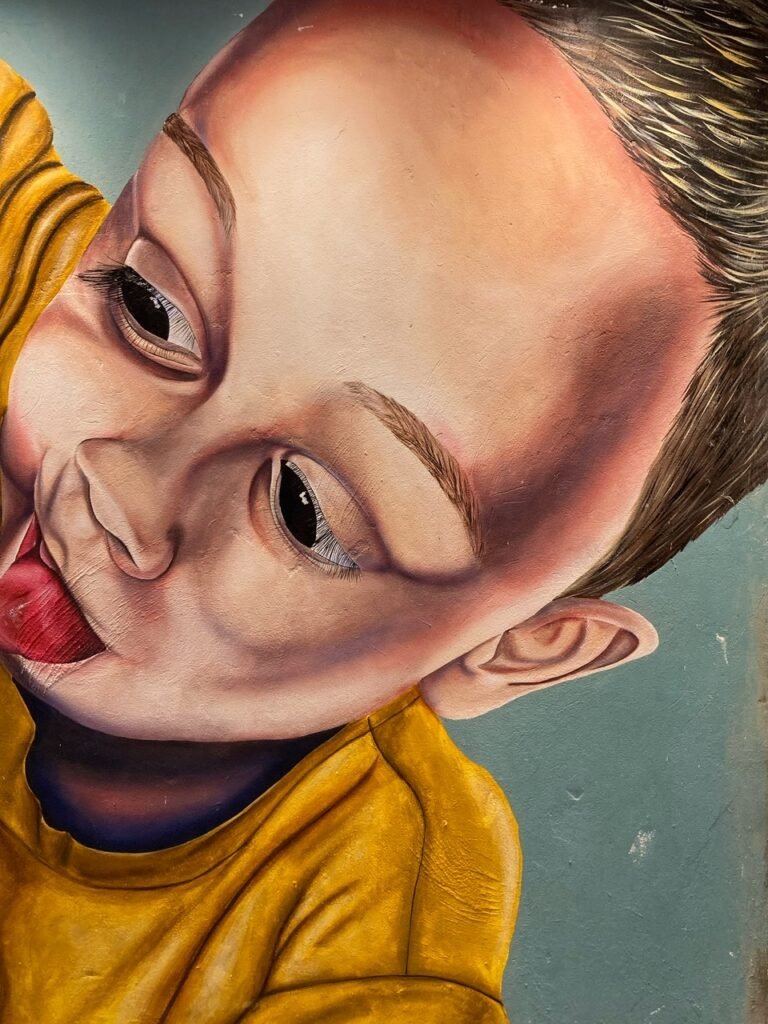
When you’re this age, maybe you’re completely oblivious to what is happening.
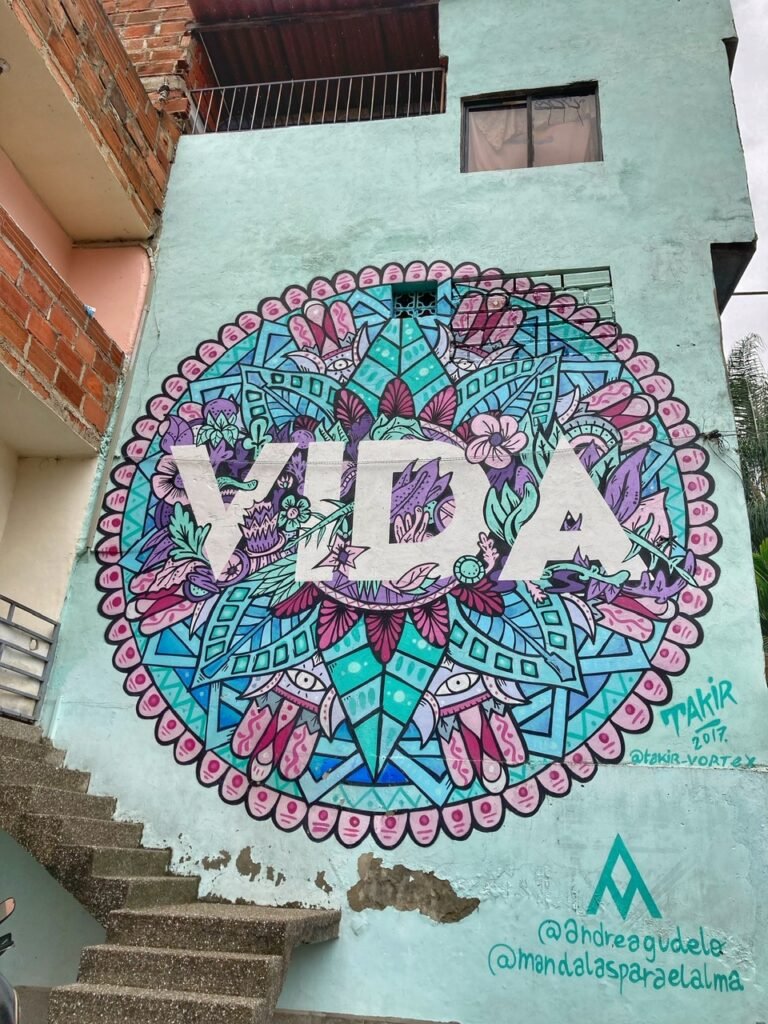
A large mural that says “VIDA” (life) welcomes you to the neighborhood. It is embedded in a sea of Hindi images. Mandy liked it so much she decided to get a t-shirt with this print.
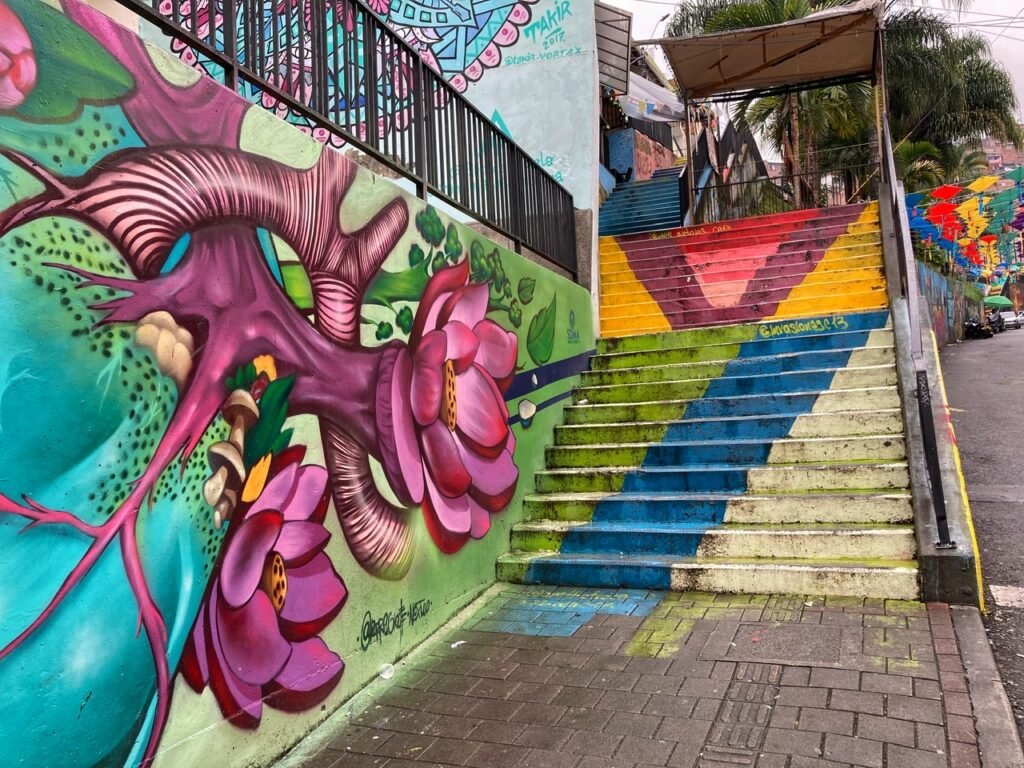
We’ve never seen so many prismatic staircases as in this neighborhood.
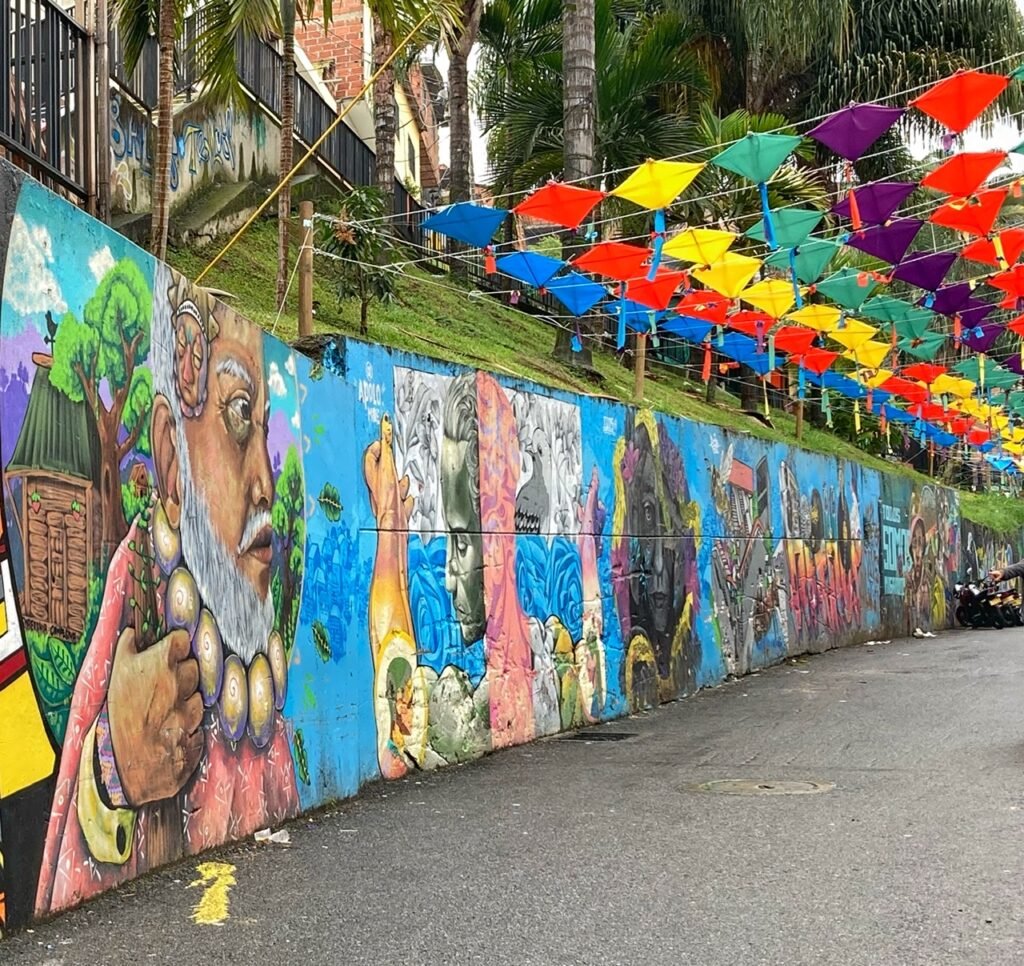
Loved that they flooded with streets with kites. It’s so much more liberating than the typical umbrellas that so many cities use.
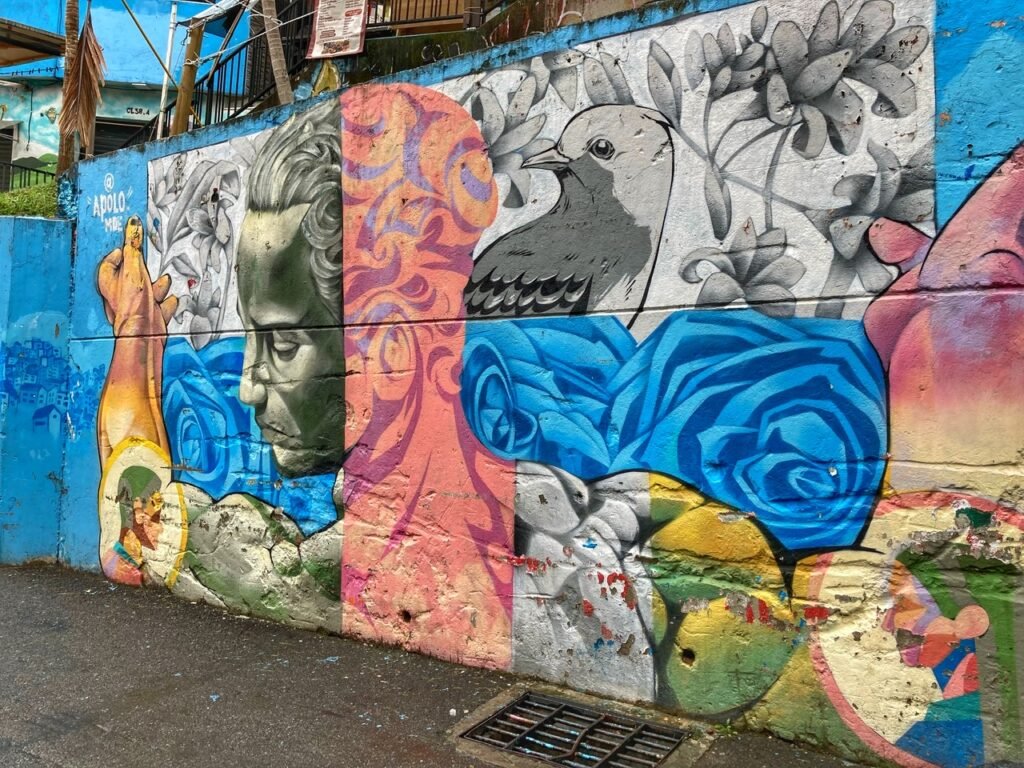
This one is interestingly in black and white, as well as color.
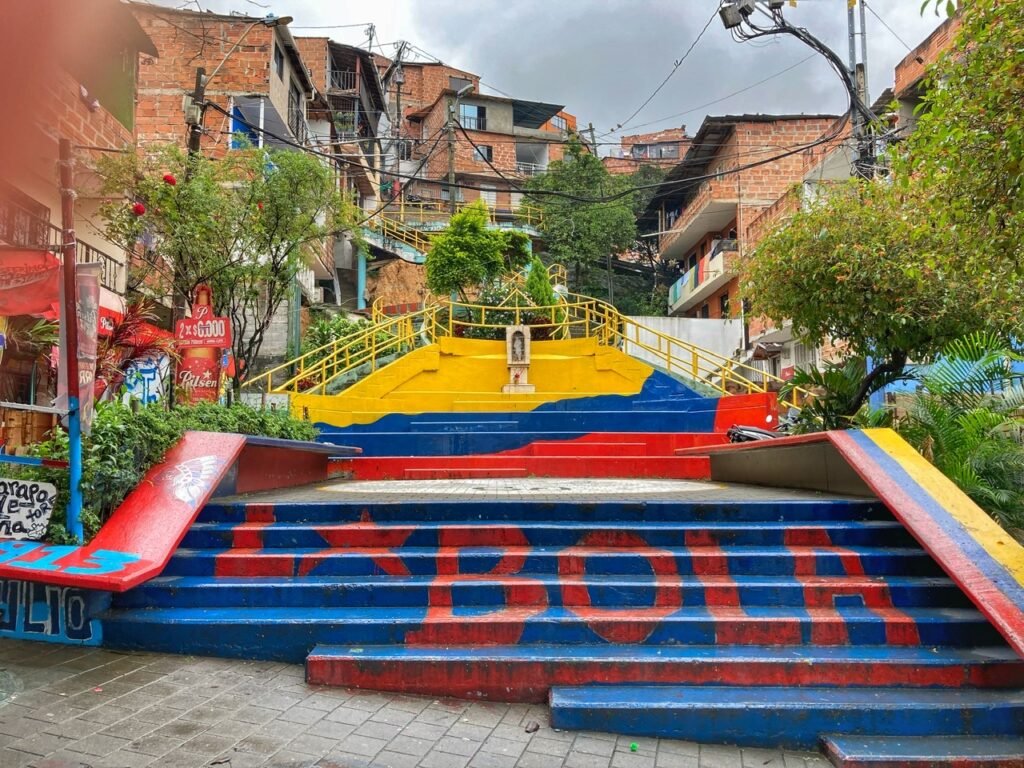
In the last twenty years, these stairs have served as a set for the filming of many famous Latin music videos.

Most of the music that has developed out of Comuna 13 has been hip hop and rap, alongside breakdance, which brings messages of peace to the community by telling stories of the past blended with positivity for the future. 40% of the population in Comuna 13 is black.
A group of street artists perform as a we were coming down from our tour.
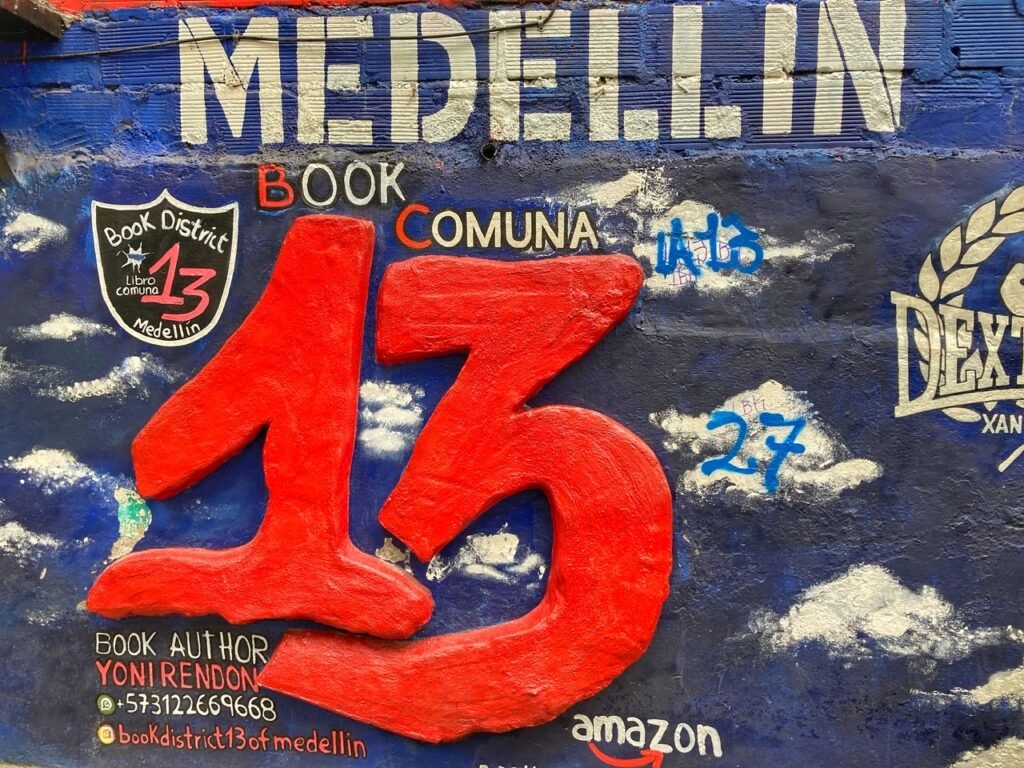
If you want to know more the history of Comuna 13, read the book. We just got it!

This mural is particularly poignant today as floods of Venezuelan refugees have been displaced to Colombia due to their own dictatorial struggles. It reads, “We are all migrants.” Seems like more than one country could use a copy of this mural.
A small slice of Comuna 13. The neighborhood, in fact, is made of 18 neighborhoods and covers 74 square kilometers. At right, a normal neighborhood street.

This cluster of flowers says, “Paisa from the patch in the Comuna 13.” Paisa is what people from Medellin are called.
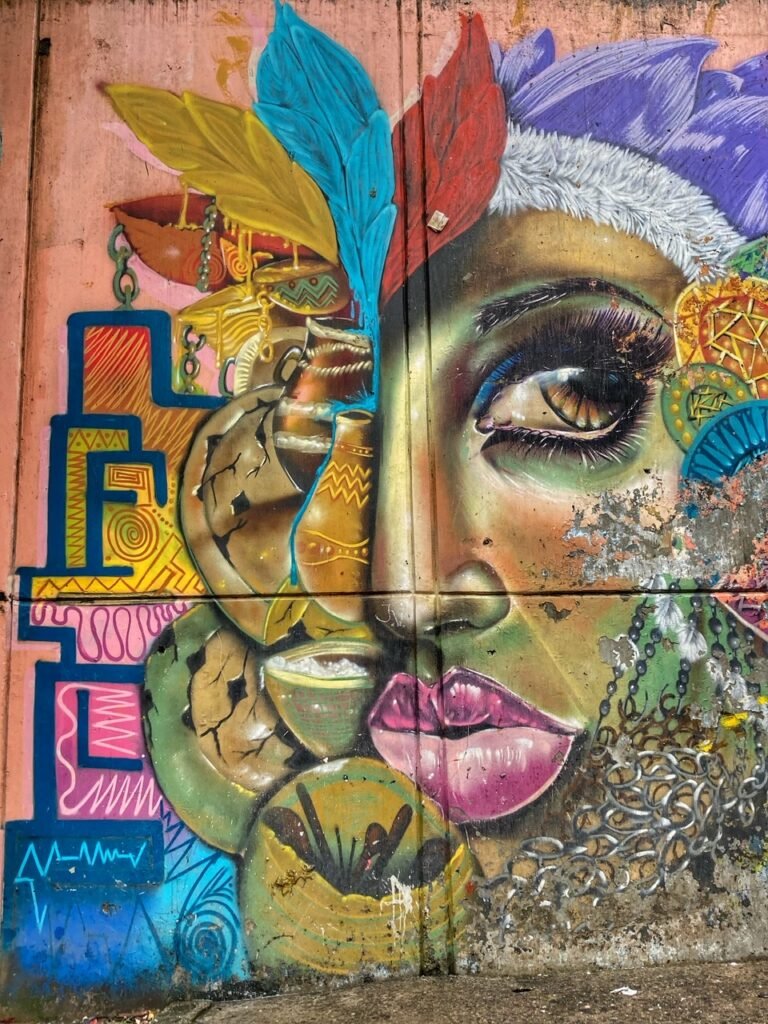
From bullets to art…Que Bonita!
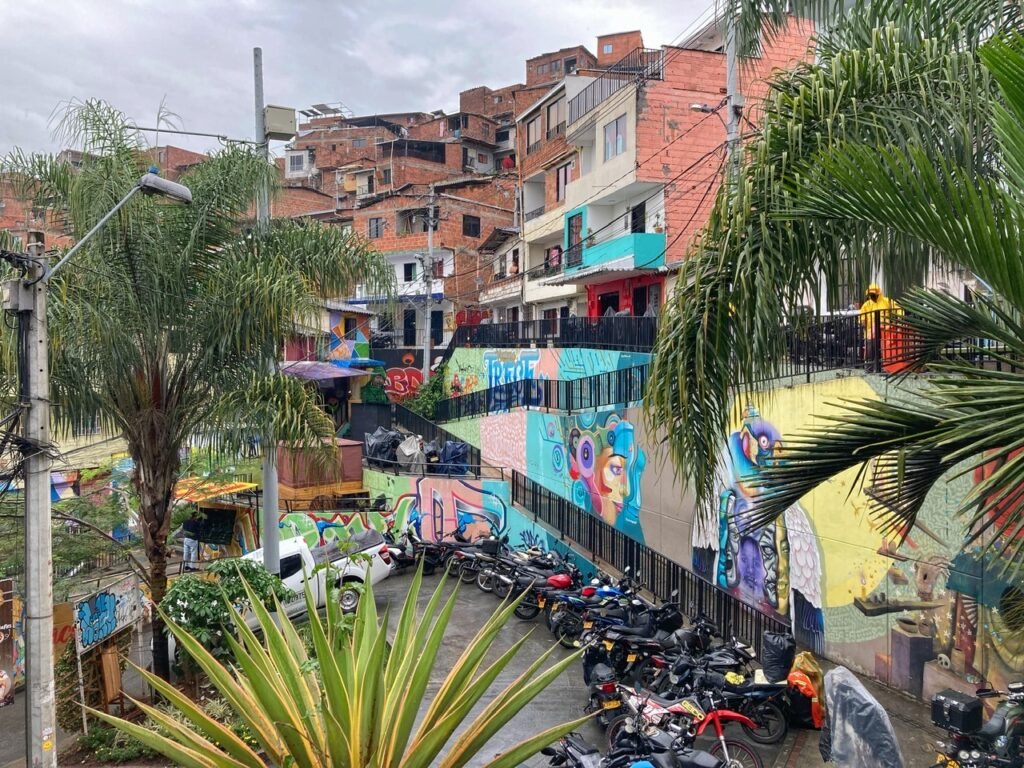
It’s truly unbelievable the changes this neighborhood has seen. Walls once riddled with bullets are now blanketed with color and art.
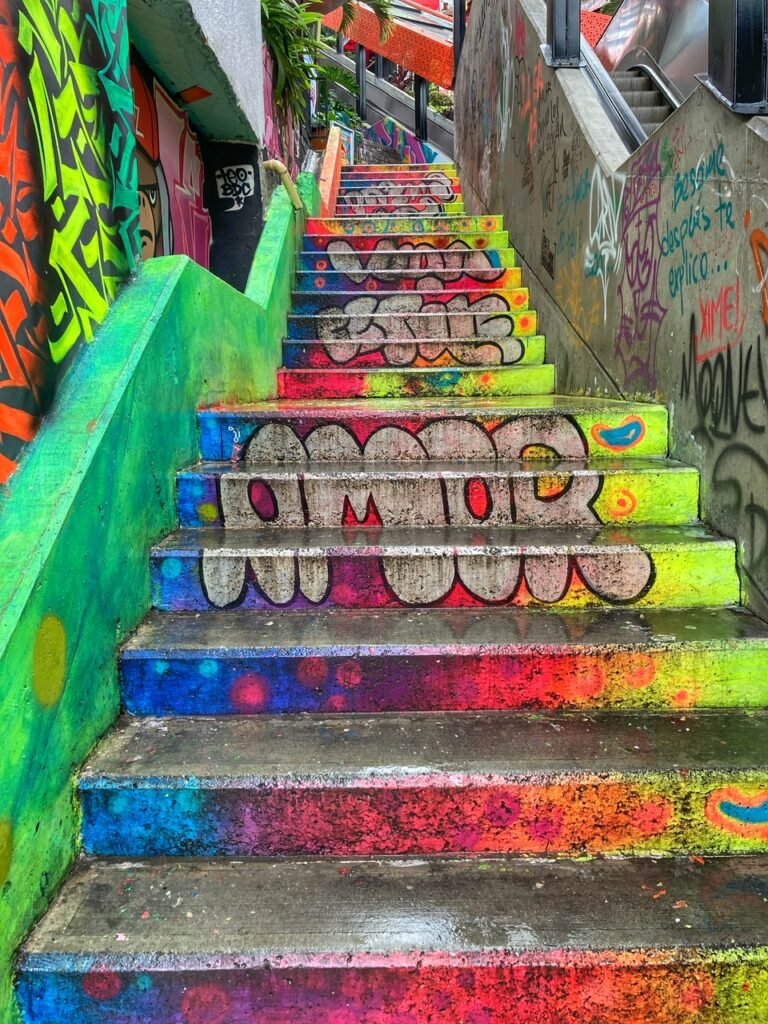
Tie-dyed stairs
There was even a really amazing gallery for black light street art. So many talented artists in this city.
Totally psychedelic! The floor of the gallery. Wow!
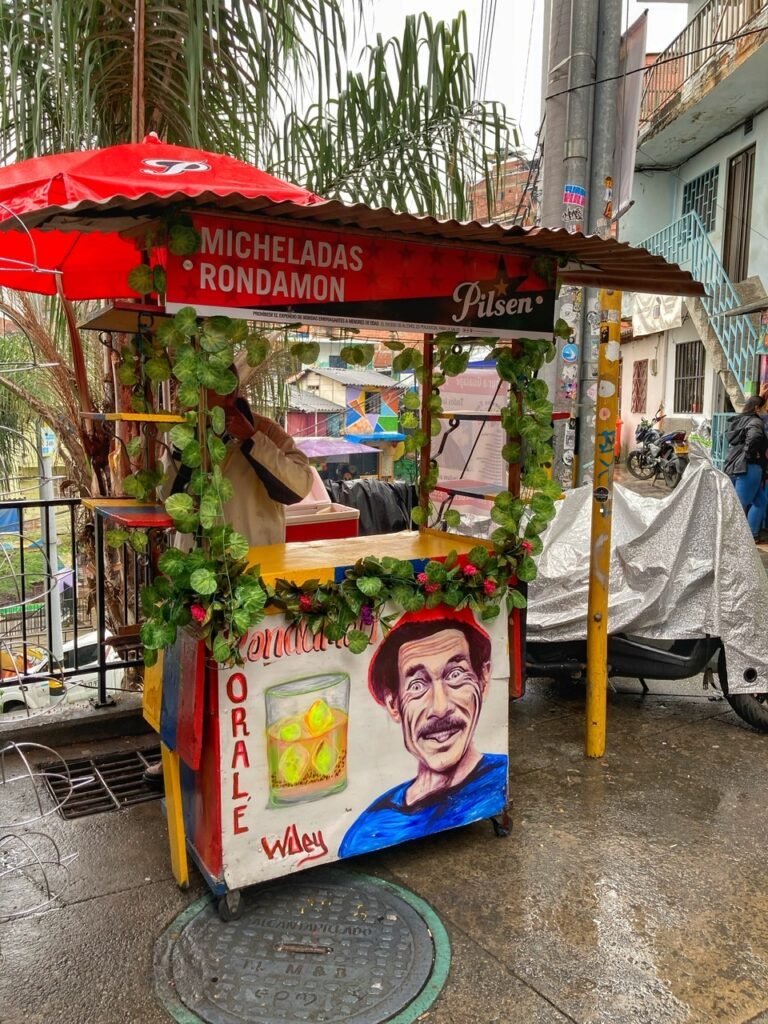
A street vendor
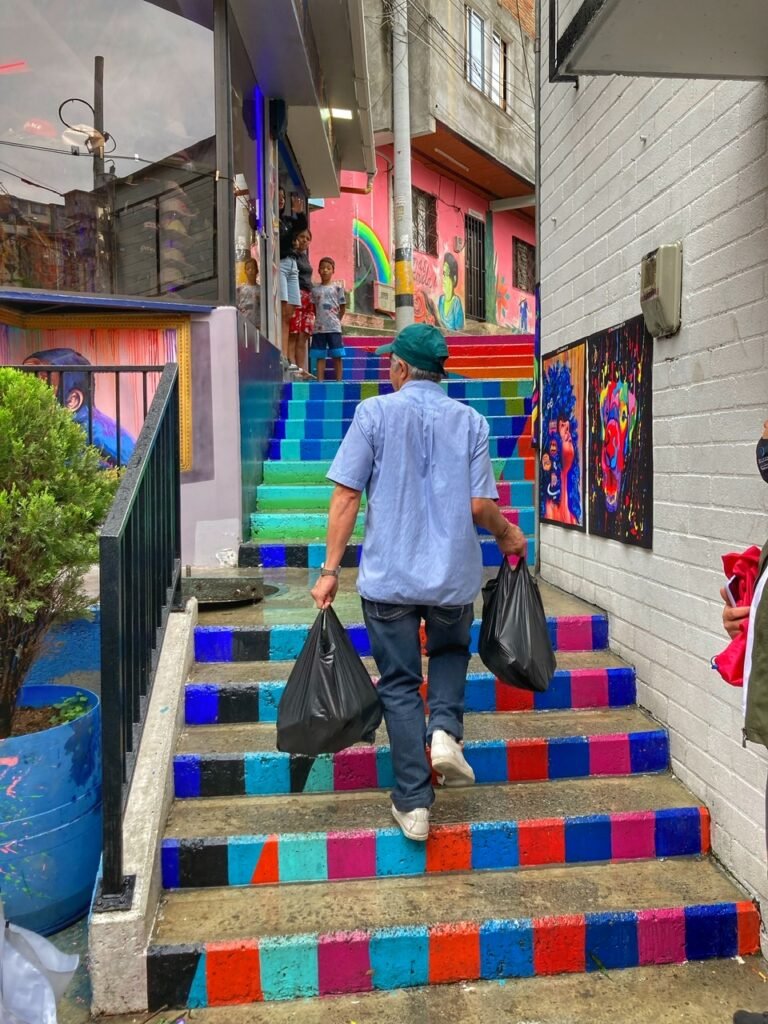
Before they put the escalators in, carrying groceries was exactly like this.

Since 2011, a series of outdoor escalators extending 384 meters flow through the neighborhood which connect once inaccessible parts to the bustling city below. These escalators have given residents a newfound freedom and shift in local mentality. Kids are playing in the streets again and tourists have been flooding the area since 2008.
Soaking in the art at one of the many galleries bursting with captivating images.
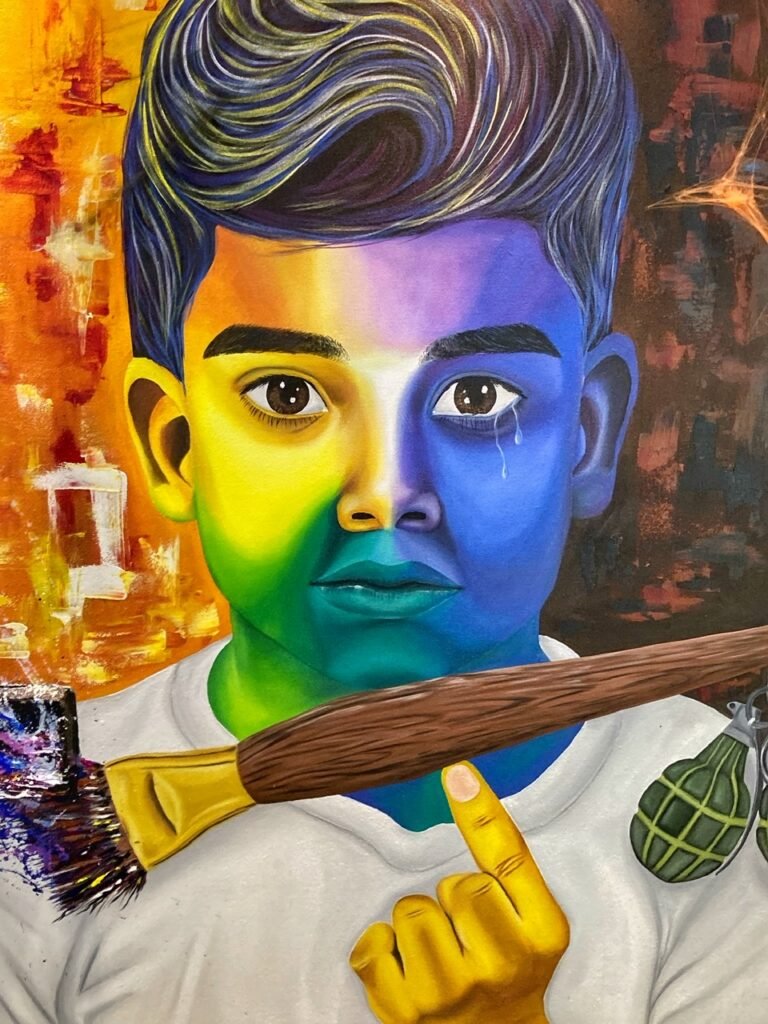
A grenade or a paintbrush. We all have a choice.
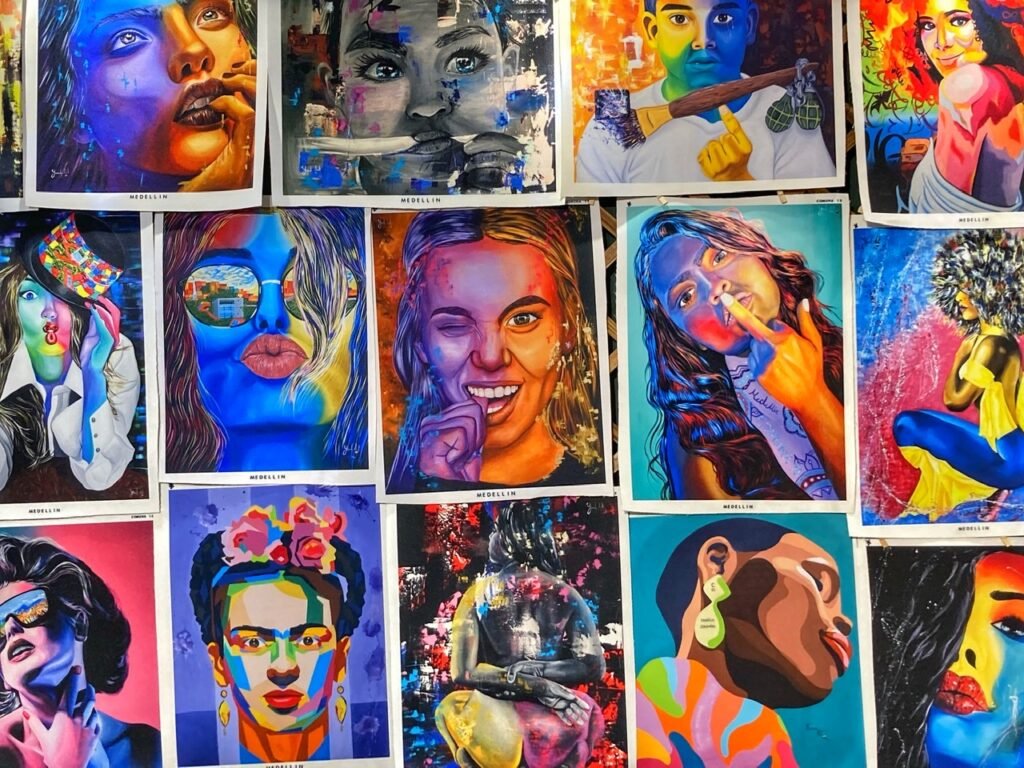
A collection of the many images available for purchase in the gallery.
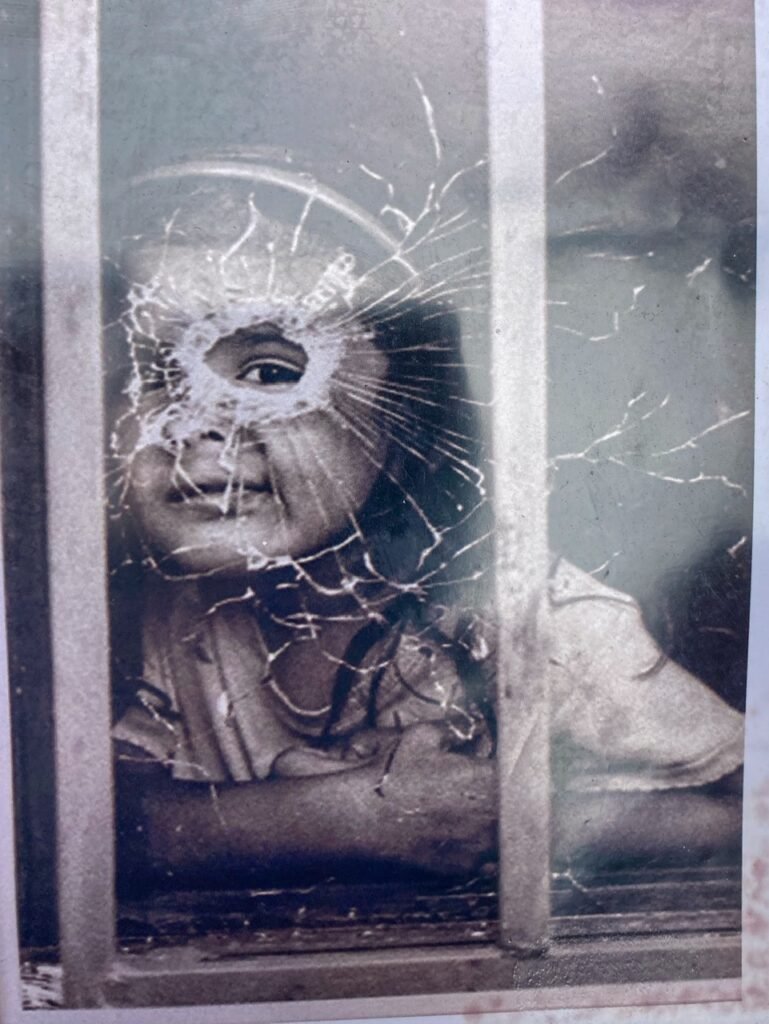
A very famous photo from this time period.
Bill Clinton visited Comuna 13 recently and went to their most famous coffeehouse, Cafe Aroma de Bario. So of course, Greg had to grab a coffee here as well.
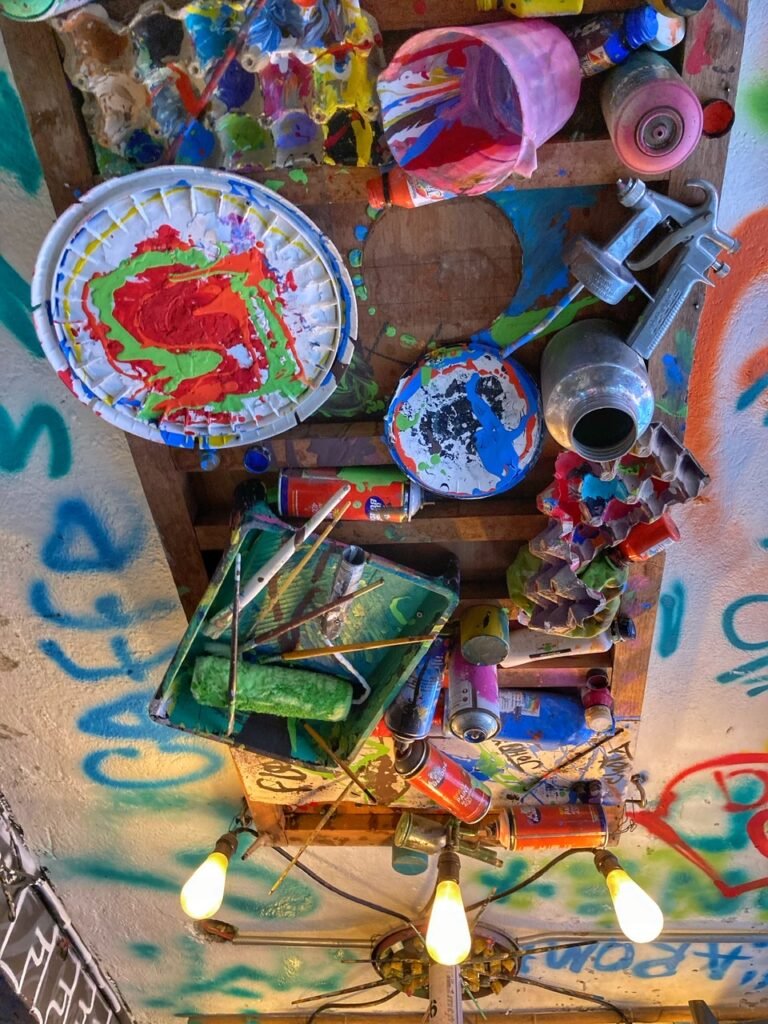
What to do with your leftover paint supplies? Attach them to the ceiling of your coffeehouse of course!
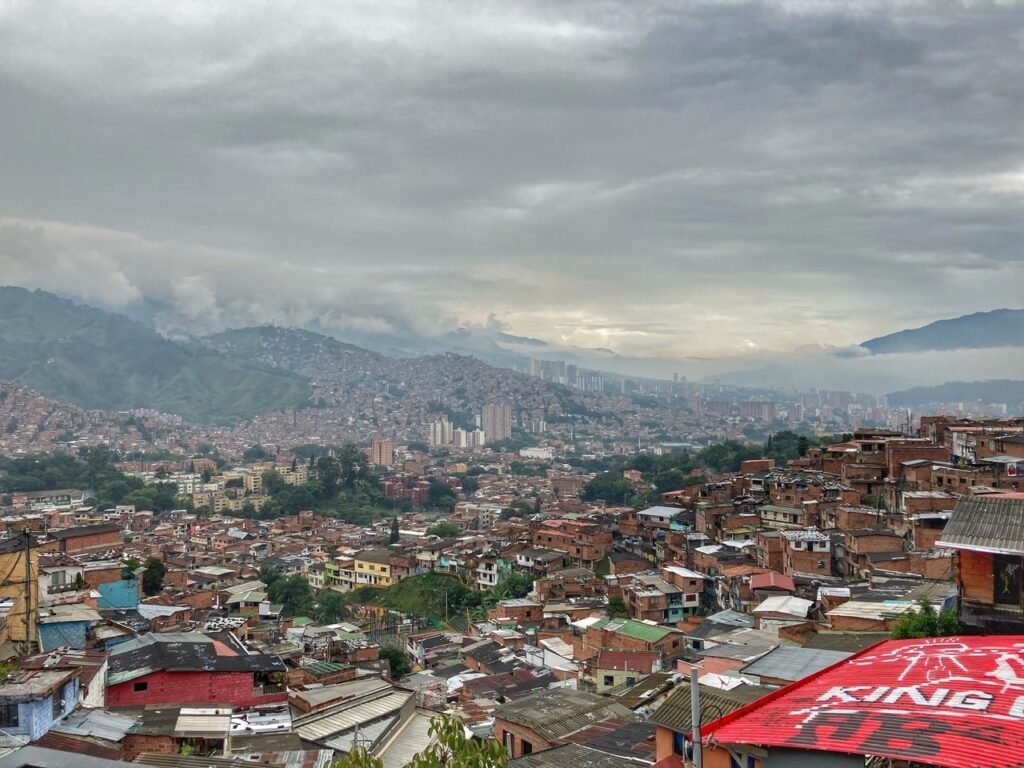
A view of Medellin from one of the lookouts in the neighborhood.
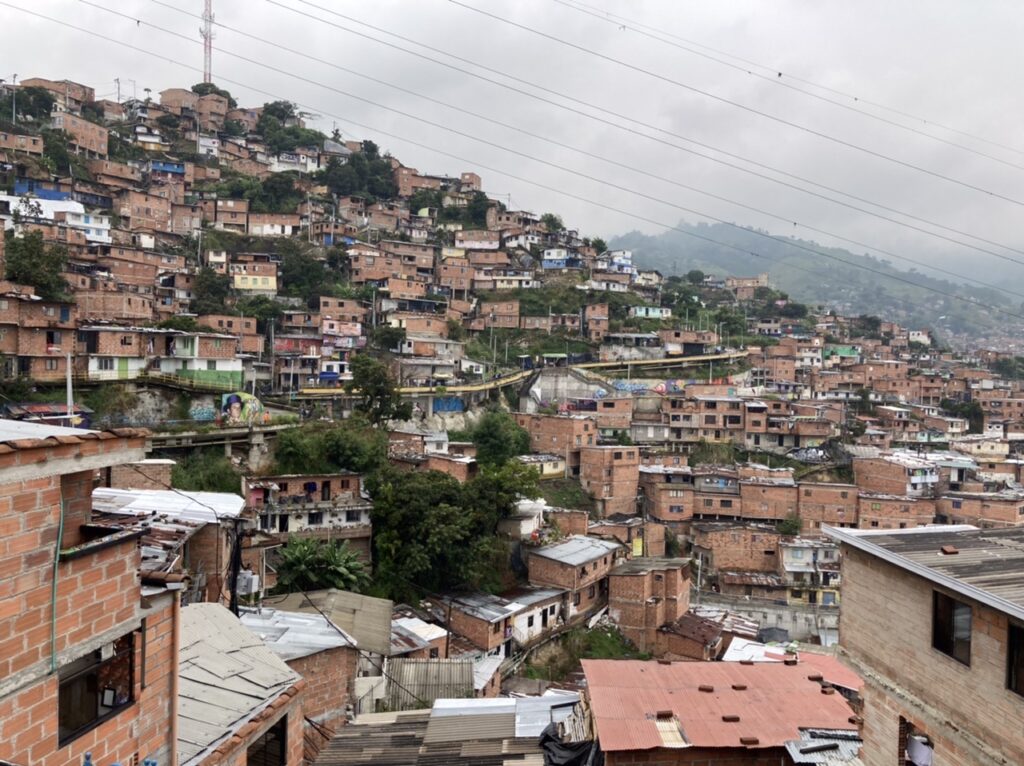
A view of Comuna 13. Just beyond it is one of the world’s largest mass urban graveyards of bodies that were deemed “disappeared” or “lost” during the 80’s and 90’s. Most kidnapped and killed by guerrillas or other military operations.
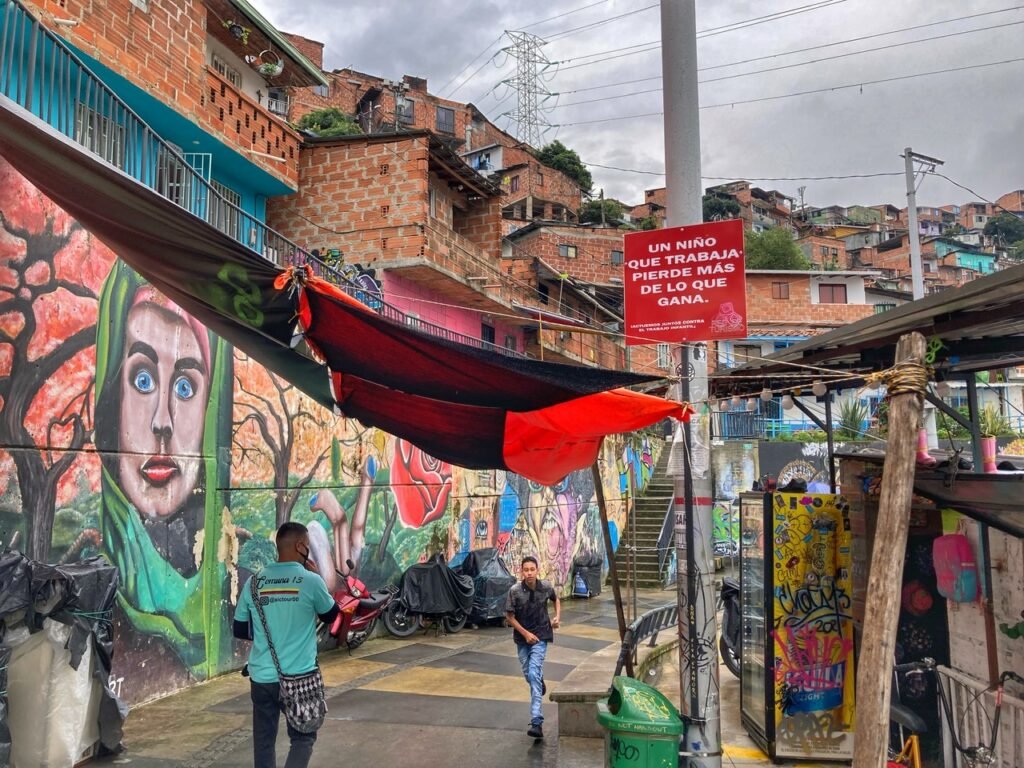
Throughout the neighborhood we noticed many signs which seemed to be public announcements. This one says, “a child who works loses more than he gains.”
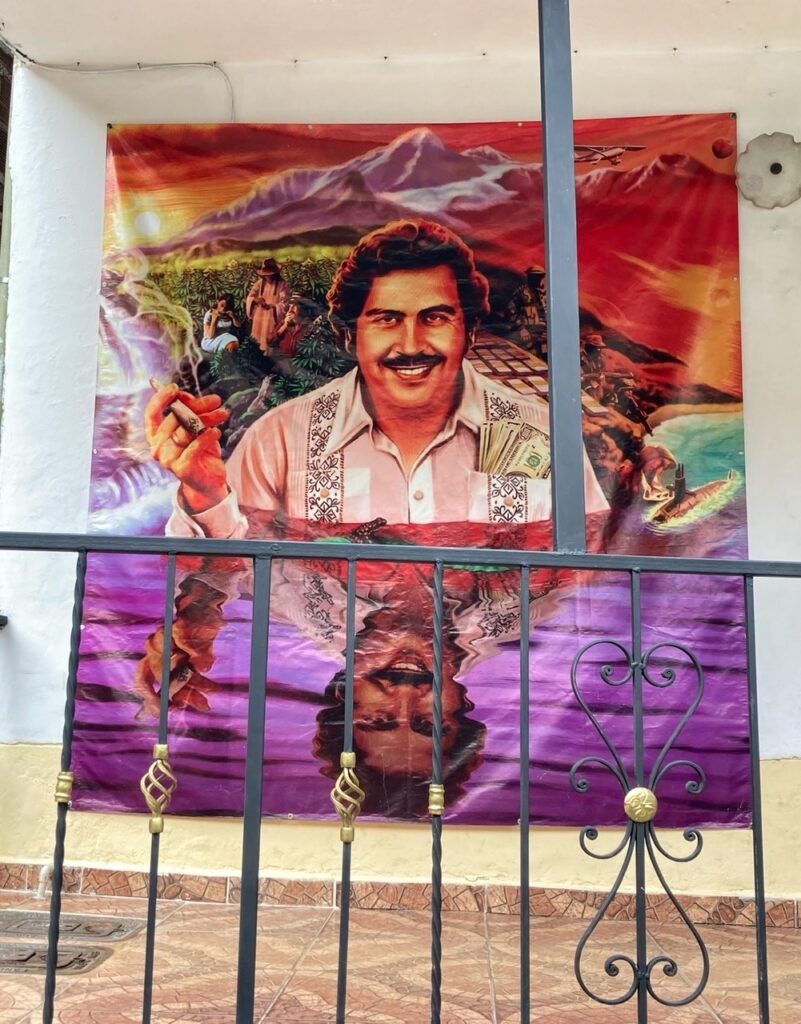
We thought this was a mural until we got closer and then realized it was actually just a giant picture of Pablo Escobar, the only one we saw anywhere in the neighborhood, and outside of someone’s home. Pablo Escobar and his cocaine drug cartels are of course what made Medellín, and particularly the Comuna 13 neighborhood, so dangerous. We learned from the guide that apparently then, and also now, there is a small percentage of the population who looks at him with hero worship and still glorifies the “good” things he did, like build houses, despite the fact he killed thousands. Hmmmm….??? During the height of its operations, the Medellín Cartel brought in more than US$70 million per day (roughly $26 billion in a year), and a large majority which was coming from…proudly the good ‘ol US of A.
Thanks to a guy in our group having a drone, we were able to get a copy of this video. This almost makes us want a drone. Almost. The aerial perspective of Comuna 13 is pretty incredible!
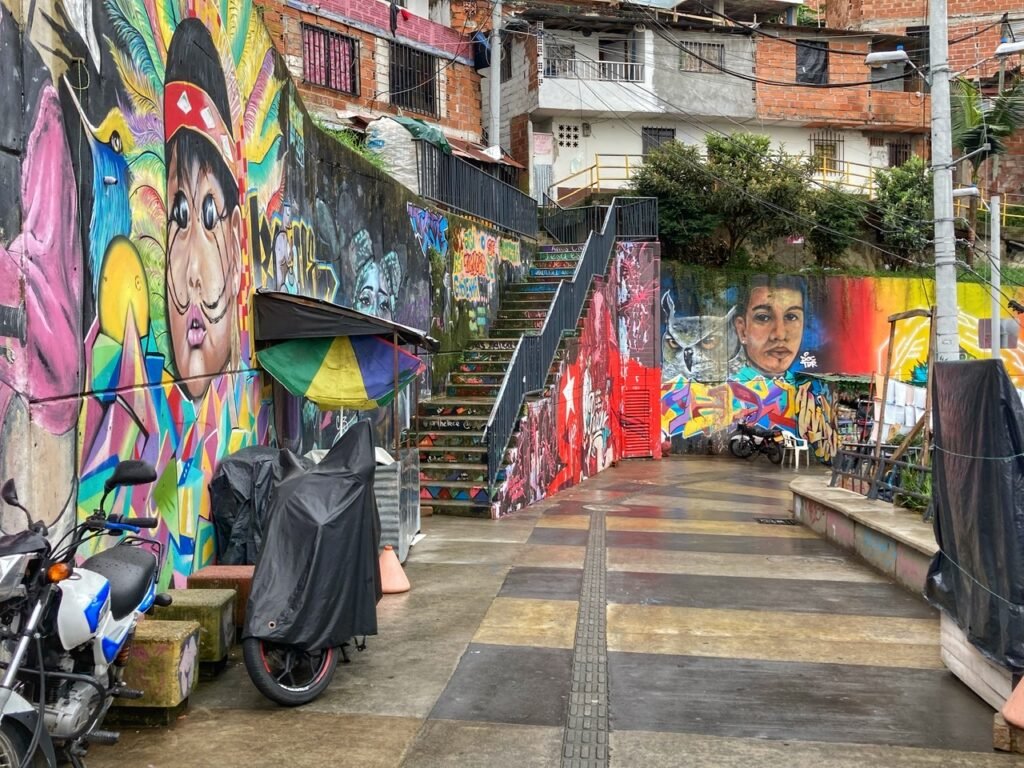
Needless to say, we are very happy to have shared such a small part of this transformation. It’s truly remarkable and gives us a lot of hope.

